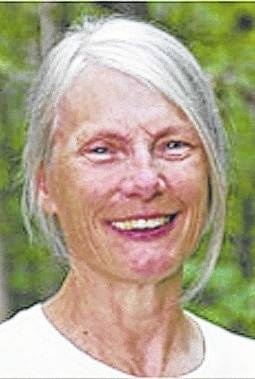
It has been a welcome change at Stratford Ecological Center on Liberty Road to have drier weather, even if it has been in the high 80s and humid.
The letup in rain came too late to save the tomatoes and peppers in field 3; they perished through lack of oxygen after a four-inch deluge, just before they were firmly established. The good news is that the farm interns have planted cold weather crops in the greenhouse, which will be transplanted in August into field 3. For the first time, we will have field grown lettuce, broccoli, cabbage, spinach, winter squash and small pumpkins to take to PIN’s special once-a-month drop off, when folks have a wider choice than usual of foods from many sources.
The first hay was brought in on June 28. Farmer Jeff was pleased with the total of 914 bales. The farmhands at the top of the conveyor belt were only too thankful to pass the bales to Ross, our young farm intern, to stack to the roof. It was very hot work, and a job best done by the young!
A torrential downpour at dinner time on Saturday, July 6, came after Farmer Jeff had finally been able to cut the 9-inch high grass in the bottom fields adjoining Rt. 23. However, he was able to salvage 240 bales a couple days later, and the farmhands stacked them in the small machine shed. He finds if it rains after he cuts a field, it dries quicker than when he cuts already wet grass. The quality made it fit only for use as bedding in the barn pens this summer. The cut grass could not just be left to decompose as the grass underneath would suffer, and this would affect the second hay cutting.
The new grass mix of meadow fescue and Italian ryegrass, called Festulolium, was used to restore the torn-up pastures and has proved a life saver. It grew quickly, and the livestock eat it as low as possible, even if there are other higher grasses accessible to them. It was only in early July that Farmer Jeff felt secure that he has enough pasture for the summer.
The oats have germinated well and are a low sea of green. With the additional rains, the water table remained high, and it only took .2 inches of rain for the water to pond on the ground. It came as no surprise that some of the corn has been lost in field 7 near the sugar shack, as it is the poorest draining field on the farm. The spelt was harvested on July 10 in record time as Farmer Jeff did not have to stop the combine due to over-heating, and the yield averaged 45 bushels/acre. The straw was baled for winter bedding. Some of the spelt was cut and baled for hay. This is an experiment to see how well it feeds compared to seed, in the event we no longer have a working combine.
Sassy’s daughter and a bull went to the processors in early July. We now have a total of 10 in our dairy/beef herd. The six kid goats are thriving, and the newly acquired La Mancha should kid soon. The three piglets have their own feeding bowl so there is no competition for feed, and they are growing steadily. The lambs are nearly as big as the ewes, yet some continue to suckle when they get a chance from their patient mother. The flock returns in the late afternoon from the pasture to the cooler barn, where a large fan helps to circulate the air. They cool off by lying down and increasing their respiration rate, which is easy to see from their heaving sides.
Carol Earich and Dan Hoover, farmhands, each cut out over 200 wooden blue bird houses to be assembled by the farm campers and taken home with instructions on how to hang them. Each house consisted of six pieces labeled A-F, with various nail holes predrilled and an entry hole, all tied together with twine. Carol and Dan took their time to make them but, in my opinion, it was still a marathon undertaking and much appreciated. Carol created each house from one cedar picket fence post. Dan used pine wood. During their week of training, the Junior Camp counselors practiced putting one together in preparation for supervising the campers. It was hilarious to watch their efforts. By the time the campers assembled the boxes a system had been devised and the assembly progressed smoothly! Bill Swoager, who monitors our blue bird boxes, followed with a talk on cavity nesters and he was impressed with their attentiveness and great questions.
The poetry and photography contests continue, and details are on our website. Story Time on the Farm is at 10 a.m. on the third Tuesday of the month and takes place weather permitting under the tree on the front lawn, $5 per family payable on the day. There are still openings in October for Small Farmers and Family Farm Chores with sign up on the website.
Our annual major fund raiser Enchanted Evening is scheduled for Thursday, Aug. 8, 5:30 to 9.30 pm. at the Africa Event Center, overlooking the Savanna at the Columbus Zoo. This year we encourage guests to create a little magic. Early arrivals at 4 p.m. may tour the zoo free. We will be paying special tribute to Clyde Gosnell, Chairman of our Board of Trustees. More details including the silent, live, and on-line auction, table and individual ticket prices, can be found on our website. We invite you to support our non-profit organization by joining us for what is always a very lovely evening.


